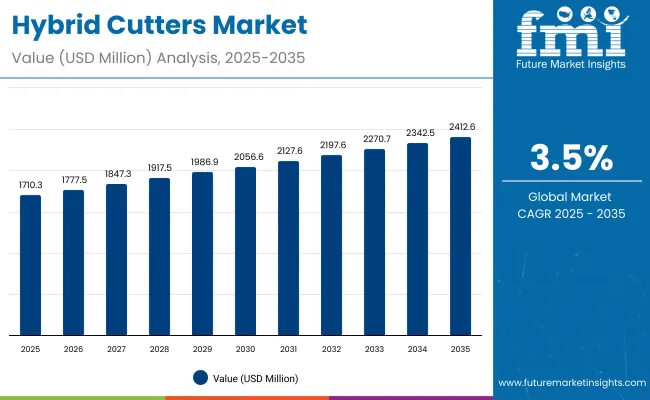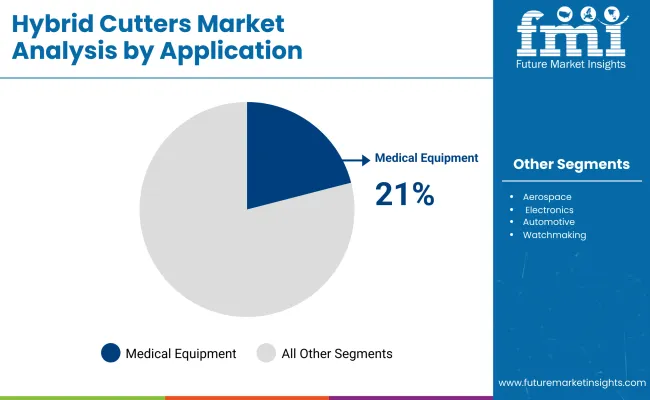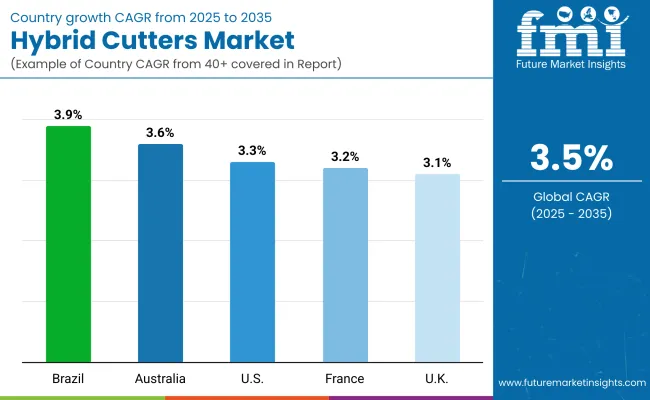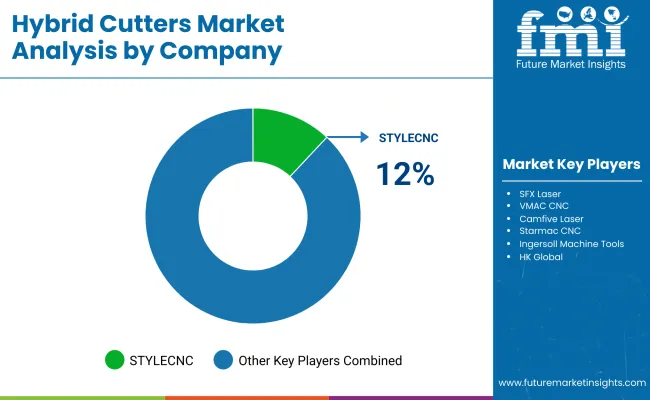The global Hybrid Cutters market is expected to be valued at USD 1.7 billion in 2025 and is projected to reach approximately USD 2.4 billion by 2035. This reflects an absolute increase of USD 702.3 million, equivalent to a growth of 41.1% over the forecast period. The expansion is forecast to occur at a CAGR of 3.5%, with the market size estimated to grow by nearly 1.4X by the end of the decade.

| Metric | Value |
|---|---|
| Industry Size (2025E) | USD 1.7 billion |
| Industry Value (2035F) | USD 2.4 billion |
| CAGR (2025 to 2035) | 3.5% |
Between 2025 and 2030, the market is projected to expand from USD 1.7 billion to nearly USD 2.0 billion, adding approximately USD 346.3 million. Growth in this first phase will be supported by the automotive industry’s shift to hybrid and lightweight materials, increased use in minimally invasive surgical applications, and the rising adoption of fully automated hybrid cutters with embedded digital controls. Industrial users and healthcare facilities are emerging as major demand drivers, ensuring precision, speed, and compliance with regulatory standards.
From 2030 to 2035, the market is expected to grow from USD 2.0 billion to USD 2.4 billion, a further increase of USD 356 million. This second phase will be shaped by the integration of AI-driven automation, laser-hybrid systems for high-precision cuts, and deeper penetration in medical robotics and advanced composite processing. Hardware refresh cycles will emphasize compact, ergonomic, and energy-efficient systems, while software upgrades will focus on real-time diagnostics, predictive calibration, and traceability for audits in healthcare and aerospace sectors.
From 2020 to 2024, the market rose from USD 1.5 billion to USD 1.7 billion, propelled by the automation of automotive assembly lines, expansion of aerospace production facilities, and increasing use of digital torque tools in precision manufacturing. Operators prioritized digital solutions over mechanical wrenches to reduce human error, ensure compliance with international quality standards, and streamline service operations. Early adoption in North America, Europe, and East Asia established the installed-base foundation for the 2025 to 2035 growth cycle.
Rise of Precision Manufacturing in Automotive
Automotive OEMs are under increasing pressure to reduce weight while improving structural integrity. Hybrid cutters, capable of handling both metal and composites, offer repeatable accuracy and higher throughput compared to conventional systems. Demand for EV chassis, battery packs, and lightweight components is expected to accelerate adoption across automotive clusters in the USA, Germany, Japan, and South Korea.
Medical Industry Adoption
Hybrid cutters are increasingly deployed in surgical applications, prosthetics, and biomedical device fabrication. Their ability to ensure micron-level precision, sterile compatibility, and software-backed traceability makes them indispensable in modern operating theatres and hospital-based fabrication units. By 2025, medical applications already represent 21% of market value, with steady expansion forecast as robotic-assisted surgeries scale.
Aerospace & Defense Expansion
Aerospace manufacturers require cutting systems that can handle advanced alloys and composites for wings, fuselage sections, and engine parts. Hybrid cutters offer reduced scrap rates, audit-grade traceability, and compliance with ISO standards critical for aviation exports. Rising production of commercial and defense aircraft in Europe, the USA, and East Asia will keep demand strong.
Shift Toward Automation
Fully automated hybrid cutters accounted for 44% of market share in 2025. Their dominance reflects industrial buyers’ preference for labor-saving, connected solutions with deterministic integration into MES and QMS systems. Semi-automated solutions are expected to retain a foothold in mid-sized workshops, while manual cutters gradually decline.
Integration of Digital & Laser Technologies
Laser-hybrid systems are growing in adoption due to their ability to achieve clean cuts, reduced downtime, and lower maintenance. Coupled with digital controls, these systems can ensure compliance with traceability mandates in medical, aerospace, and automotive industries, making them a crucial driver of next-generation adoption.

The medical equipment sector holds the largest share at 21% in 2025, as hospitals, device makers, and research labs adopt hybrid cutters for prosthetics, robotic-assisted surgeries, and hospital-based fabrication labs. Precision, traceability, and cleanroom compatibility make these cutters critical in meeting healthcare compliance and patient safety standards.
Automotive strengthens demand by embedding cutters into EV battery packs, ADAS modules, and lightweight chassis frames, where repeatability reduces warranty claims. Aerospace operators rely on micron-level, NIST-aligned cutters for turbine blades, wing composites, and fuselage structures, where traceability is mandatory for regulatory audits. Electronics and construction form secondary demand pools, where hybrid cutters support compact production setups and ruggedized field operations.

Fully automated hybrid cutters account for 44% of global demand in 2025, driven by Industry 4.0 adoption and labor cost pressures. Automotive and aerospace OEMs deploy them for throughput efficiency and reduced rework. Semi-automated units retain significance in mid-scale workshops and SMEs, balancing flexibility with cost. Manual cutters, though declining, still hold relevance in price-sensitive regions and legacy industries.
Laser cutters still dominate with 65% market share in 2025, offering micron-level accuracy that appeals to aerospace and medical sectors. Advanced niche types like waterjet-laser hybrids are being deployed in defense, composites, and high-value fabrication, signaling a shift toward specialty use cases.
Shift Toward Cleanroom-Compatible and Low-Noise Cutters
Medical and electronics buyers increasingly demand low-vibration, low-noise hybrid cutters that can function inside cleanrooms and controlled environments. Hospitals use them in prosthetic labs and surgical device workshops, while semiconductor fabs integrate compact, quiet cutters into highly automated production lines. Manufacturers emphasize sealed, easy-to-sanitize frames, anti-static enclosures, and deterministic Ethernet connectivity for seamless MES integration. This trend strengthens hybrid cutters’ role in industries where precision must coexist with strict contamination control.
Integration of Smart Software and Data Connectivity
End-users are moving beyond hardware, attaching higher value to software integrations that link cutters directly into WMS, ERP, and QMS platforms. Automotive and aerospace OEMs rely on real-time traceability logs, image-backed proof of precision, and cloud-based audit trails to meet regulatory demands. The ability to feed cutting records into enterprise software not only improves compliance but also reduces dispute cycles in cross-border supply chains. As a result, vendors are prioritizing API-first architectures and data validation modules alongside hardware.
Sustainability and Long-Lifecycle Equipment Demand
European and North American buyers are pushing suppliers toward energy-efficient cutters with longer lifecycles. EV and aerospace manufacturers, under pressure to decarbonize supply chains, prefer cutters that combine low power consumption, modular replaceable parts, and predictive maintenance modules. This reduces downtime, lowers total cost of ownership, and supports ESG reporting frameworks. Vendors that position their cutters as part of a circular manufacturing ecosystem - with recyclable frames and reduced consumables - are gaining a competitive edge.

The USA Hybrid Cutters Market, valued at USD 325.1 million in 2025, is projected to expand at 6.6% CAGR through 2035. Growth is anchored in Detroit’s EV platforms, where OEMs require torque + cut precision for battery packs and chassis frames. Aerospace hubs in Seattle and Texas adopt NIST-traceable cutters for engines and landing gear, ensuring FAA audit compliance. Dealer networks and independent workshops are also adopting connected systems that attach cutting/torque proof to VIN-level warranty records, supporting transparency in aftermarket servicing.
Japan’s Hybrid Cutters Market, worth USD 59.9 million in 2025, grows steadily through 2035 on the back of automation-heavy manufacturing ecosystems. Compact, conveyor-ready cutters dominate adoption, aligning with Japan’s lean, organized industrial floors. Automotive OEMs integrate cutters into hydrogen and EV assembly lines, while medical growth accelerates as the country’s aging population drives robotic surgery and prosthetic demand. Aerospace suppliers emphasize ISO-certified systems that deliver traceable, image-backed logs for export-grade compliance.
South Korea’s market, valued at USD 41.1 million in 2025, accelerates as EV platforms and electronics fabs demand cleanroom-ready, low-noise hybrid cutters. Hyundai and Kia anchor automotive uptake, embedding cutters into drivetrain and battery production lines. Aerospace suppliers prioritize compliance with international safety standards, while electronics manufacturers deploy cutters in export-oriented fabs, ensuring deterministic Ethernet connectivity with MES systems.
The Europe Hybrid Cutters Market is projected to grow at a 3.3% CAGR (2025 to 2035), supported by strong demand from medical equipment, aerospace, and automotive manufacturing hubs. Germany and France anchor adoption, with their med-tech and aerospace clusters, while Italy and Spain strengthen demand through automotive, packaging, and composites machining. The UK drives momentum with investments in robotics and automation, while BENELUX nations push hybrid cutters into electronics, specialty machining, and cleanroom environments. Europe’s ESG and CE-compliance frameworks are fueling demand for cutters with energy-efficient drives, recyclable frames, and validated traceability features.
Germany accounts for the largest share of Europe’s market, with adoption fueled by its medical technology hubs at Berlin and Tuttlingen, aerospace machining centers, and EV manufacturing clusters (Bavaria, Baden-Württemberg). Hospitals and med-tech OEMs rely on hybrid cutters for precision surgical instruments and prosthetics, while automotive OEMs integrate automated cutters for battery packs, chassis modules, and EV drivetrains. Aerospace contractors use micron-level cutters for turbine blade and wing assembly programs. Germany’s Industry 4.0 leadership ensures deep integration of cutters into smart factories.
France’s hybrid cutters market is anchored by aerospace (Toulouse, Bordeaux) and medical manufacturing clusters (Lyon, Paris). Airbus programs create demand for cutters with traceability, compliance-ready audit logs, and micron-level accuracy. Meanwhile, France’s growing medical device exports rely on cleanroom-compatible cutters to meet EU MDR standards. Automotive demand is steady, with Renault and Stellantis embedding cutters into EV component manufacturing. Government sustainability initiatives push suppliers to offer energy-efficient, recyclable machines that align with France’s green transition agenda.
The UK market benefits from robotics integration, defense programs, and advanced manufacturing hubs. Medical equipment and aerospace applications dominate, with hospitals and labs deploying cutters for prosthetics and surgical devices, while aerospace suppliers support BAE Systems and Rolls-Royce production. The UK also sees rising demand in industrial automation and electronics, fueled by investments in smart factories. Service-based models are gaining traction, as SMEs prefer cutters with predictive maintenance contracts and cloud-based data services.
Italy’s hybrid cutters market is led by automotive machining (Turin, Emilia-Romagna) and medical equipment exports. EV production and luxury car makers embed cutters into assembly and prototyping, while medical OEMs deploy them for prosthetics and surgical device fabrication. Italy also shows strong demand in packaging and composites machining, driven by its industrial hubs in Lombardy and Veneto. SMEs prefer semi-automated cutters that balance precision and cost efficiency.
Spain’s hybrid cutters market is supported by aerospace hubs including Seville, and Madrid, and automotive plants in Catalonia and Valencia. Aerospace suppliers rely on micron-level cutters for composite fuselages and defense programs. Automotive OEMs embed hybrid cutters for EV batteries, lightweight chassis, and structural modules. Spain also sees adoption in renewables and construction, as hybrid cutters support machining of wind turbine components and prefabricated structures.
BENELUX countries (Belgium, Netherlands, Luxembourg) adopt hybrid cutters for electronics, specialty machining, and advanced materials. The Netherlands drives demand with semiconductor fabs and cleanroom-compatible cutters. Belgium’s aerospace and defense suppliers add further adoption, while Luxembourg’s niche industries adopt cutters for precision machining and composites. BENELUX is also an early adopter of compact, energy-efficient hybrid cutters aligned with EU sustainability mandates.

The Hybrid Cutters Market is increasingly solution-driven, with vendors bundling hardware, software, and service contracts. Companies are focusing on AI-enabled automation, predictive calibration, and medical-grade traceability to differentiate offerings. STYLECNC dominates the global hybrid cutters market with around 12% share.
| Item | Value |
|---|---|
| Quantitative Units | USD 1.7 billion (2025) |
| Automation Level | Fully Automated, Semi Automated, Manual |
| By Cutter Type | Conventional hybrid cutters, Laser hybrid cutters |
| By Application | Medical Equipment, Aerospace, Electronics, Automotive, Watchmaking, Other Applications |
| Regions Covered | North America, Europe, East Asia, South Asia & Pacific, Latin America, Middle East & Africa |
| Countries Covered | United States, Germany, United Kingdom, Japan, China, France, Italy, South Korea, Spain, BENELUX |
| Key Companies Profiled | STYLECNC, SFX Laser, VMAC CNC, Camfive Laser, Starmac CNC, Ingersoll Machine Tools, HK Global, Muratec, Mazak Corporation, and EMAG GmbH & Co. KG |
The global Hybrid Cutters Market is estimated at USD 1.7 billion in 2025, driven by the shift to automated precision cutting in automotive, medical, and aerospace applications.
The market is projected to reach USD 2.4 billion by 2035, reflecting adoption of AI-driven hybrid cutting systems and medical-grade applications.
The market is forecast to expand at a CAGR of 3.5%, supported by automation growth, composite material adoption, and robotic-assisted surgery demand.
Fully Automated systems lead with a 44% share in 2025, reflecting efficiency and precision advantages.
The Medical Industry accounts for 21% of 2025 revenue, with the fastest growth projected through 2035.
Key companies include STYLECNC, SFX Laser, VMAC CNC, Camfive Laser, Starmac CNC, Ingersoll Machine Tools, HK Global, Muratec, Mazak Corporation, and EMAG GmbH & Co. KG.






Our Research Products

The "Full Research Suite" delivers actionable market intel, deep dives on markets or technologies, so clients act faster, cut risk, and unlock growth.

The Leaderboard benchmarks and ranks top vendors, classifying them as Established Leaders, Leading Challengers, or Disruptors & Challengers.

Locates where complements amplify value and substitutes erode it, forecasting net impact by horizon

We deliver granular, decision-grade intel: market sizing, 5-year forecasts, pricing, adoption, usage, revenue, and operational KPIs—plus competitor tracking, regulation, and value chains—across 60 countries broadly.

Spot the shifts before they hit your P&L. We track inflection points, adoption curves, pricing moves, and ecosystem plays to show where demand is heading, why it is changing, and what to do next across high-growth markets and disruptive tech

Real-time reads of user behavior. We track shifting priorities, perceptions of today’s and next-gen services, and provider experience, then pace how fast tech moves from trial to adoption, blending buyer, consumer, and channel inputs with social signals (#WhySwitch, #UX).

Partner with our analyst team to build a custom report designed around your business priorities. From analysing market trends to assessing competitors or crafting bespoke datasets, we tailor insights to your needs.
Supplier Intelligence
Discovery & Profiling
Capacity & Footprint
Performance & Risk
Compliance & Governance
Commercial Readiness
Who Supplies Whom
Scorecards & Shortlists
Playbooks & Docs
Category Intelligence
Definition & Scope
Demand & Use Cases
Cost Drivers
Market Structure
Supply Chain Map
Trade & Policy
Operating Norms
Deliverables
Buyer Intelligence
Account Basics
Spend & Scope
Procurement Model
Vendor Requirements
Terms & Policies
Entry Strategy
Pain Points & Triggers
Outputs
Pricing Analysis
Benchmarks
Trends
Should-Cost
Indexation
Landed Cost
Commercial Terms
Deliverables
Brand Analysis
Positioning & Value Prop
Share & Presence
Customer Evidence
Go-to-Market
Digital & Reputation
Compliance & Trust
KPIs & Gaps
Outputs
Full Research Suite comprises of:
Market outlook & trends analysis
Interviews & case studies
Strategic recommendations
Vendor profiles & capabilities analysis
5-year forecasts
8 regions and 60+ country-level data splits
Market segment data splits
12 months of continuous data updates
DELIVERED AS:
PDF EXCEL ONLINE
Hybrid Sleeve Cartridges Market Analysis - Size and Share Forecast Outlook 2025 to 2035
Hybrid Reactive Power and Harmonic Compensation Device Market Size and Share Forecast Outlook 2025 to 2035
Hybrid Vision Sensor Chips Market Size and Share Forecast Outlook 2025 to 2035
Hybrid Printing Market Forecast Outlook 2025 to 2035
Hybrid Boat Market Size and Share Forecast Outlook 2025 to 2035
Hybrid Metal-Paper Seamers Market Size and Share Forecast Outlook 2025 to 2035
Hybrid Sealing-Cut Machines Market Analysis - Size and Share Forecast Outlook 2025 to 2035
Hybrid Powertrain Market Size and Share Forecast Outlook 2025 to 2035
Hybrid Additive Manufacturing Machines Market Size and Share Forecast Outlook 2025 to 2035
Hybrid Integration Platform Market Size and Share Forecast Outlook 2025 to 2035
Hybrid Marine Gensets Market Size and Share Forecast Outlook 2025 to 2035
Hybrid Meat Products Market Size and Share Forecast Outlook 2025 to 2035
Hybrid Generator Sets Market Size and Share Forecast Outlook 2025 to 2035
Hybrid Switchgear Market Size and Share Forecast Outlook 2025 to 2035
Hybrid Rice Seeds Market Size and Share Forecast Outlook 2025 to 2035
Hybrid Memory Cube Market Size and Share Forecast Outlook 2025 to 2035
Hybrid Aircraft Market Size and Share Forecast Outlook 2025 to 2035
Hybrid Solar Wind Market Size and Share Forecast Outlook 2025 to 2035
Hybrid Fabrics Market Size and Share Forecast Outlook 2025 to 2035
Hybrid Train Market Analysis - Size, Share, and Forecast Outlook 2025 to 2035

Thank you!
You will receive an email from our Business Development Manager. Please be sure to check your SPAM/JUNK folder too.
Chat With
MaRIA